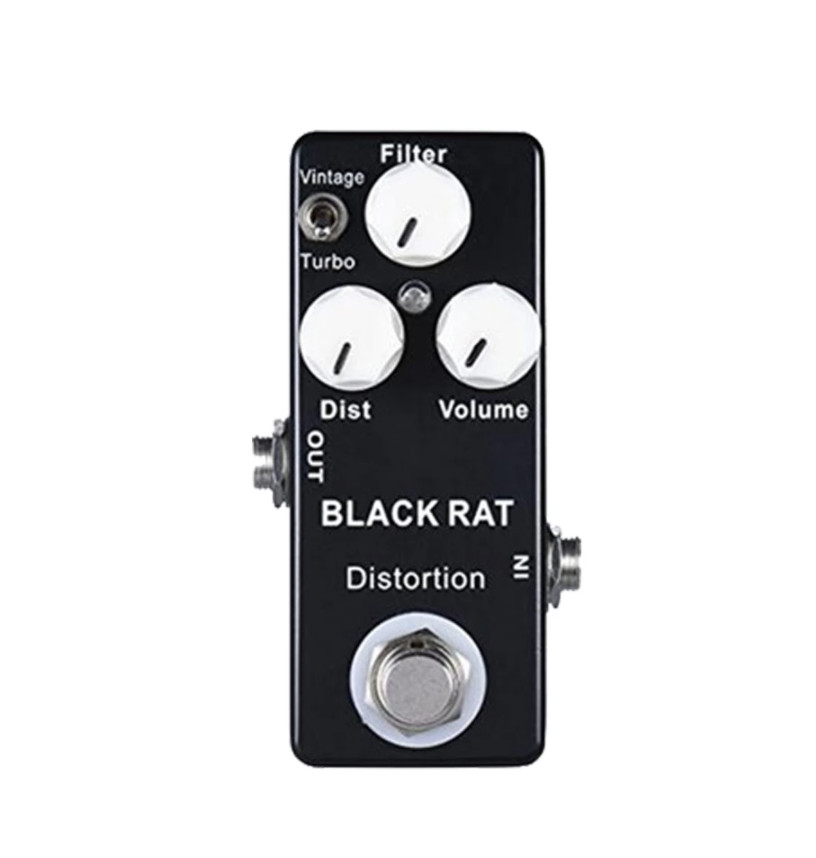The RAT pedal is a legendary name in the world of guitar effects, revered for its versatile distortion, overdrive, and even fuzz tones. Its impact on music is undeniable, shaping the sound of countless guitarists across genres. For those seeking that iconic RAT sound without breaking the bank, the market is flooded with affordable clones. Among these budget-friendly options is the Mosky Black Rat pedal, a contender that promises to deliver the RAT experience at an unbelievably low price. But does it live up to the hype, or more importantly, to the sound of the original? Let’s dive into a detailed review of the Mosky Black Rat and see if this ultra-cheap pedal is a worthy addition to your guitar rig.
 Mosky Black Rat distortion pedal, a budget-friendly clone of the classic guitar RAT pedal, placed on a white surface
Mosky Black Rat distortion pedal, a budget-friendly clone of the classic guitar RAT pedal, placed on a white surface
Mosky Black Rat: An Overview of Features and Cost
Priced incredibly affordably at around $30-$40 on major online marketplaces like Amazon, the Mosky Black Rat immediately grabs attention with its budget-friendly appeal. For guitarists looking to experiment with RAT-style distortion without a significant investment, the Mosky Black Rat presents itself as an enticing option. This pedal aims to be a straightforward clone of the classic RAT circuit, featuring the familiar trio of controls: Distortion, Filter, and Volume. These knobs allow players to sculpt their tone, ranging from gritty overdrive to thick distortion and even fuzz-like saturation.
Adding to its versatility, the Mosky Black Rat incorporates a two-way toggle switch labeled “Vintage” and “Turbo.” This switch is designed to offer two distinct RAT voicings in a single pedal. The “Vintage” mode intends to emulate the standard, classic RAT sound, while the “Turbo” mode aims to replicate the hotter, more aggressive tones of the Turbo RAT variant, known for its increased gain and fuzzier character. From a practical standpoint, the pedal features an offset input and output jack design, a thoughtful touch that aids in pedalboard placement and cable management, especially on crowded boards. Despite its low cost, the Mosky Black Rat boasts a surprisingly robust and sturdy feeling enclosure, suggesting a level of build quality that belies its price tag.
Sound and Performance: Is It a True Guitar RAT Pedal?
In direct comparison to benchmark RAT pedals like the Pro Co RAT2 and the Wampler Ratsbane, the Mosky Black Rat reveals some notable sonic differences. One of the immediate distinctions is its muddier and bass-heavy character. While not inherently negative, this deviates from the more articulate and mid-focused nature often associated with traditional RAT pedals. It appears that the Mosky Black Rat exhibits less of the characteristic mid-scoop that helps a RAT pedal cut through a mix. This sonic profile can be perceived as thicker and warmer, offering a rich distortion texture, but it lacks the clarity and definition to truly replicate the classic RAT sound.
Furthermore, the Mosky Black Rat seems less responsive and flexible in terms of tone shaping compared to its higher-end counterparts. The controls, while functional, don’t offer the same degree of nuanced tonal sculpting found in pedals like the RAT2 or Ratsbane. While it can produce usable distortion tones, achieving the precise and versatile range of sounds that a genuine RAT pedal is known for proves challenging. The pedal’s “Turbo” mode, while advertised as a hotter and fuzzier setting, primarily manifests as a volume boost with a slightly altered tonal character. It doesn’t quite capture the pronounced gain increase and fuzz-like edge that define a Turbo RAT. Similarly, achieving the coveted “edge of fuzz” sound that RATs are famous for, even in Turbo mode, remains elusive with the Mosky Black Rat.
While the boosted output of the Turbo mode can be beneficial, especially considering the somewhat lower output of the Vintage mode, it doesn’t fundamentally transform the pedal into a true Turbo RAT experience. Ultimately, while the Mosky Black Rat provides a distortion effect, it doesn’t convincingly replicate the sonic nuances and dynamic response of a genuine Guitar Rat Pedal. For guitarists seeking that authentic RAT sound, this pedal might fall short of expectations. As an alternative in the same price range, a used Boss DS-1 could arguably serve as a more versatile and RAT-like distortion option for stage or studio use.
Conclusion: Final Verdict on the Mosky Black Rat
The Mosky Black Rat pedal, while attractively priced and seemingly well-built for its cost, ultimately underperforms as a true clone of a guitar RAT pedal. Earning a score of 4 out of 10, it’s not a complete failure, but it doesn’t quite hit the mark for those specifically seeking the iconic RAT sound. It’s important to consider that the Pro Co RAT2, the benchmark for RAT pedals, is readily available at a reasonable price point, and even used Boss DS-1 pedals, often considered a good budget distortion, can be found for comparable prices. For a pedal aiming to replicate a readily affordable classic, the compromises in sound quality become more apparent.
However, the Mosky Black Rat is not without its merits. It can function as a decent, budget-friendly distortion pedal, particularly for guitarists who favor a bass-heavy, rhythm-oriented sound. It could also be useful for layering in mixes where a less defined, thicker distortion texture is desired. For musicians on an extremely tight budget who need a distortion pedal and are not specifically chasing the authentic RAT tone, the Mosky Black Rat is an option worth considering. If budget constraints are less critical and the goal is to obtain a true RAT-like sound, investing in a Pro Co RAT2 or exploring alternatives like a Boss DS-1 would be more advisable. While the Mosky Black Rat may not replace a genuine RAT on a main pedalboard, it could serve as a supplementary distortion flavor for experimental or budget-conscious players.
